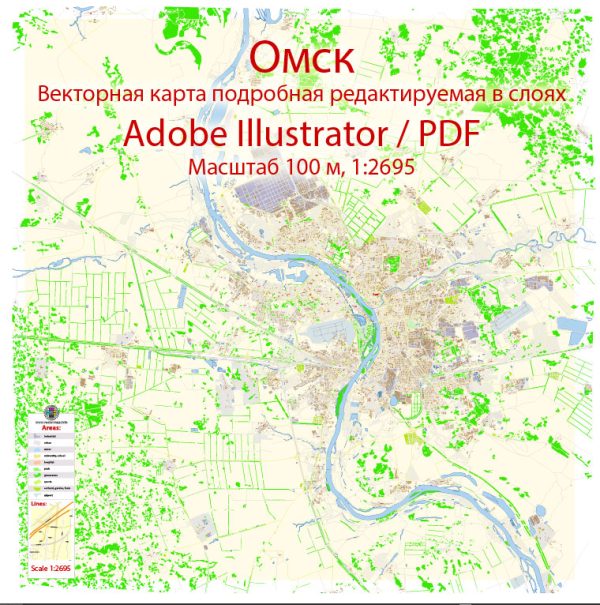Omsk, located in southwestern Siberia, Russia, is a city with a rich history that dates back to the 18th century.
Vectormap.Net provide you with the most accurate and up-to-date vector maps in Adobe Illustrator, PDF and other formats, designed for editing and printing. Please read the vector map descriptions carefully.
Here is a detailed description of some of the historic places, buildings, streets, and squares in Omsk:
- The Omsk Fortress: The city’s history began with the construction of the Omsk Fortress in 1716. This fortress played a crucial role in the defense against nomadic tribes and served as an administrative and military center. Today, parts of the original fortress walls and gates are preserved, providing a glimpse into Omsk’s early history.
- Lenin Street: Lenin Street is one of the central thoroughfares in Omsk, lined with historic buildings, shops, and cafes. The street is named after Vladimir Lenin, and it serves as a bustling hub for locals and tourists alike. Architectural highlights along this street include 19th-century merchant houses and buildings from the Soviet era.
- Tarskaya Street: Tarskaya Street is another historic street in Omsk, known for its well-preserved wooden houses from the 19th century. The street has a charming atmosphere and is a great place to explore traditional Siberian architecture.
- Assumption Cathedral: One of the prominent landmarks in Omsk is the Assumption Cathedral, built in the late 19th century. This architectural masterpiece features a blend of Russian and Byzantine styles and is an important religious site in the city.
- The Governor’s House: The Governor’s House, also known as the House of Merchant Bantyshov, is a 19th-century mansion located in the city center. It is an example of Omsk’s pre-revolutionary architecture and has a unique design with elements of Renaissance and Baroque styles.
- Drama Theater: The Omsk Drama Theater is an iconic cultural institution with a history dating back to the 19th century. The theater building itself is an architectural gem and hosts a variety of performances, including plays, ballets, and operas.
- Leningrad Square: Leningrad Square is a significant public space in Omsk, surrounded by important buildings such as the Omsk State Academic Drama Theater and the City Administration building. The square is often used for public events, festivals, and celebrations.
- Omsk State Museum of History and Regional Studies: This museum provides a comprehensive overview of Omsk’s history, showcasing artifacts, documents, and exhibits that illustrate the city’s development from its founding to the present day.
- Monument to the Conquerors of the Siberian Land: Located in Victory Park, this monument commemorates the Russian pioneers and Cossacks who played a crucial role in the conquest and colonization of Siberia.
These are just a few examples of the historic places, buildings, streets, and squares that contribute to the cultural and architectural heritage of Omsk. Exploring these sites provides a fascinating journey through the city’s past and its role in Siberian history.


 Author: Kirill Shrayber, Ph.D.
Author: Kirill Shrayber, Ph.D.